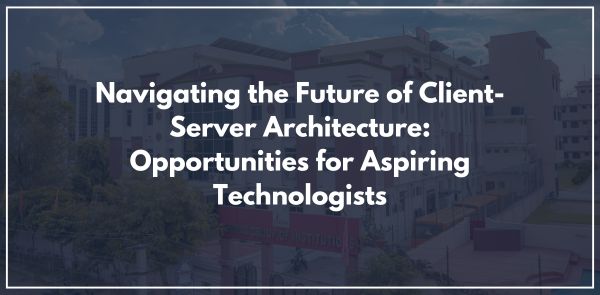
Navigating the Future of Client-Server Architecture: Opportunities for Aspiring Technologists
Ms. Kritika Pal Saini
Assistant Professor
Poddar International College, Jaipur
___________________________________________________________
Introduction: In the realm of modern computing, the client-server architecture serves as the backbone of countless applications and services, enabling seamless communication and data exchange across networks. As technology continues to evolve, the significance of client-server architecture persists, offering a promising pathway for aspiring technologists. Poddar International college is the best Computer Science Engineering college in Rajasthan .The future scope it holds for students aspiring to enter the field of technology.
Understanding Client-Server Architecture: At its core, client-server architecture is a model for distributed computing where tasks and resources are divided between clients and servers. Clients, which can be any device or application that initiates requests, interact with servers, which store and process data, and respond to these requests accordingly. This division of labor allows for efficient resource utilization, scalability, and centralized management of data and services.
Evolution and Adaptation: The evolution of client-server architecture mirrors the advancements in technology and the changing landscape of computing. Early implementations relied on centralized servers to handle all client requests, leading to scalability and performance limitations. However, as networks grew more complex and demands for scalability increased, distributed architectures emerged. Today, with the advent of cloud computing and the Internet of Things (IoT), client-server architecture has evolved to support a wide range of applications and devices, from web browsers to smartphones and IoT sensors.
Future Scope: The future of client-server architecture is bright, driven by the ongoing digital transformation across industries and the proliferation of connected devices. As businesses seek to leverage data-driven insights and real-time communication, the demand for scalable and efficient client-server solutions will only continue to grow. Moreover, emerging technologies such as edge computing, 5G networks, and artificial intelligence present new opportunities for innovation and optimization within client-server architectures.
Emerging Trends: Several emerging trends are shaping the future of client-server architecture, offering exciting opportunities for students to explore. Edge computing, for example, involves deploying servers closer to the point of data generation, reducing latency and improving performance for applications that require real-time responsiveness. Similarly, the rise of microservices architecture and containerization technologies, such as Docker and Kubernetes, enable greater agility and scalability in building and deploying client-server applications.
Importance of Skill Development: To excel in the field of client-server architecture, students must develop a diverse set of skills encompassing networking, system administration, programming, and cloud computing. Proficiency in programming languages like Python, JavaScript, or Java is essential for building client and server-side applications, while knowledge of networking protocols and security principles is crucial for ensuring the integrity and confidentiality of data transmissions. Additionally, familiarity with cloud platforms such as Amazon Web Services (AWS) or Microsoft Azure is becoming increasingly valuable as organizations migrate their infrastructure to the cloud .Best colleges provide free azure course and Aws course Certifications like Poddar International College .
Educational Pathways: Students interested in pursuing careers in client-server architecture have various educational pathways to consider. Traditional computer science programs provide a strong foundation in theoretical concepts and practical skills relevant to client-server development, including algorithms, data structures, and distributed systems. Alternatively, specialized courses and certifications focused on networking, cloud computing, or software development can offer targeted training tailored to specific career objectives.
Building Practical Experience: Beyond formal education, students can enhance their skills and credentials by gaining practical experience through internships, projects, and hands-on experimentation. Participating in open-source software development, contributing to community forums, or undertaking personal projects can provide valuable exposure to real-world client-server challenges and solutions. Additionally, pursuing internships or co-op placements at tech companies or research institutions can offer invaluable insights into industry best practices and emerging trends.
Conclusion: In conclusion, client-server architecture remains a cornerstone of modern computing, facilitating the seamless exchange of data and services across networks. As technology continues to advance and new opportunities emerge, the future of client-server architecture holds immense potential for students aspiring to pursue careers in technology. By investing in skill development, pursuing educational opportunities, and gaining practical experience, aspiring technologists can position themselves for success in this dynamic and ever-evolving field.